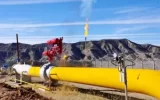Analyzing the Tehran-Eshghabad contract; Iran is on the way to the regional gas hub

According to Energy Press; Gurbanguly Bardimohamedov, the national leader of Turkmenistan, visited Iran on August 28 and had a conversation with Iran’s President Masoud Bezikian. In this regard, four strategic memorandums were signed between the two countries, which according to experts, the document signed between the state gas companies of Iran and Turkmenistan will turn Iran into a regional gas transmission hub. Of course, the details of this document have not yet been published.
According to Turkmen media reports, Gurbanguly Berdimohamedov has proposed the implementation of joint projects with Iranian companies to increase the volume of gas supply to Iran to 40 billion cubic meters per year. The Turkmen side also reported that in the Tehran talks, Turkmenistan’s electricity export to Iran was examined.
Strategic importance for Turkmen gas
experiencing the negative consequences of extensive dependence on the Russian-controlled gas pipeline network to transport energy to foreign markets; It prompted Turkmen authorities to seek alternative routes. In this regard, the first pipeline that transported Turkmenistan’s gas to foreign markets by bypassing Russian territory was the Karpeche-Kordkoi pipeline (Turkmenistan-Iran gas pipeline), which was built in 1997 with a capacity of 6 to 8 billion cubic meters of gas. It was built in Also, the authorities of the two countries agreed to increase the gas supply capacity up to 20 billion cubic meters by operating another gas pipeline called Daulat Abad-Sarkhs-Naziran with the ability to transfer 12 gases.
Therefore, Iran has always played an important role in Turkmenistan’s foreign energy policy. The Turkmenistan-Iran gas trade was not only the first successful attempt to diversify Turkmenistan’s total dependence on Russia, but also contributed to Turkmenistan’s budget, which is heavily dependent on gas export revenues. But while Turkmenistan has the ability to transfer 20 billion cubic meters to Iran, the volume of gas transfer never reached its full capacity.
Importing gas from Turkmenistan has been more cost-effective for Iran than building internal pipelines to transfer its gas from fields in the south to consumers in the north and increase gas production capacity. Of course, over the past few years, Iran has been implementing its gas development program (production capacity and infrastructure) to fully meet its gas demand from its own sources.
But Iran has always sought to export Turkmenistan’s gas to other countries and become a hub for its gas. Azizullah Ramezani, Director of International Affairs at Iran National Gas Company at the time, emphasized that our proposal is to transfer gas from Azerbaijan and Turkmenistan to Iran and then export it to Europe through Turkey. This is the most economical way to transport gas to Europe. However, critics argue that there is no major pipeline network capable of transporting gas imported from Turkmenistan through Iran and through Turkey to Europe. There are two pipelines to transfer gas from Turkmenistan to the northern regions of Iran and one pipeline to transfer gas from Iran to Turkey with a capacity of 10 billion cubic meters. Nevertheless, the existing gas pipeline infrastructure allows the indirect transmission of Turkmenistan’s gas to Europe.
Therefore, Iran aims to achieve self-sufficiency in gas supply by developing its unexploited potential. While this led to a rapid decrease in gas trade between Turkmenistan and Iran in recent years. But despite the recent gas deficit and lack of necessary infrastructure, there are still prospects for future cooperation between these two countries in the gas sector. Although a pipeline network may not be specifically designed to connect Turkmenistan’s gas to European markets through Iran, it is clearly possible to participate in gas exchange for the benefit of all parties involved.
In the framework of such gas trade arrangements, Iran will fully benefit from the existing pipelines and profits from gas transit and swaps. Turkmenistan, in turn, will have access to the European gas market by avoiding Russian territory. Of course, being overly dependent on the Chinese-only market makes Turkmenistan highly vulnerable to the threat of gas supply disruption by a single customer. In this regard, the existing gas pipeline infrastructure for gas transmission to Iran is an important part of the diversification strategy of Turkmenistan’s gas export routes. These major factors indicate that both Iran and Turkmenistan will be interested in continuing gas trade arrangements in the future.
Tags:gas
- Comments sent by you will be published after approval by site administrators.
- Comments that contain slander will not be published.
- Comments that are not in Persian or not related to the news will not be published.

Comments
Total comments : 0 Awaiting review : 0 Date: 0